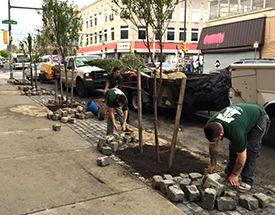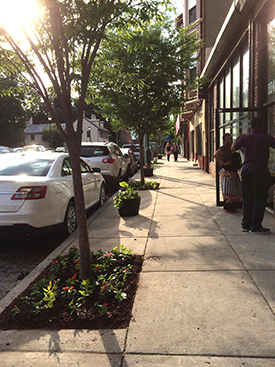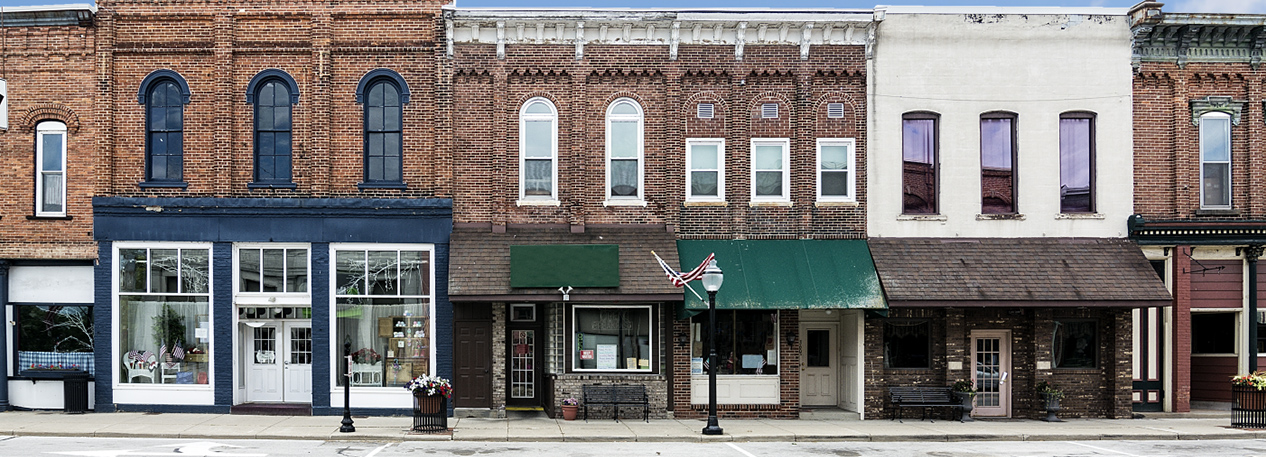In this article, the case of Philadelphia is used to explore the extent to which such neighborhood commercial corridors live up to their promise of maintaining public order and city civility, what factors make these corridors neighborhood assets rather than liabilities, and how a city might make more use of its corridors, especially in lower- and middle-income areas.
The Philadelphia region, especially the city proper, is rich in the districts Jacobs lauded: pedestrian-oriented, storefront retail corridors integrated into the surrounding neighborhood. The Philadelphia City Planning Commission (PCPC) has officially counted 265 "retail centers" in the city, ranging from those in the central business district with millions of square feet of leasable space, to suburban-style shopping malls, to block-long neighborhood corridors.2 In 2002, 42 percent of these corridors were of the traditional pedestrian-oriented variety, with the rest being either auto-oriented or a mix of auto- and pedestrian-oriented, and 75 percent were neighborhood centers with 10,000 to 120,000 square feet of leasable space.
Not all traditional corridors are an asset to their neighborhoods. A block of vacant storefronts, take-out restaurants, and check-cashing stores with bullet-proof glass inside, metal roll-down grates outside, and empty upper floors can act as a magnet for crime and serves as a negative advertisement for the surrounding neighborhood. On the other hand, a corridor with a range of complementary businesses with attractive window displays, where merchants and property owners have pooled their resources to provide amenities such as street banners, furniture, street cleaning, or security, will attract street traffic and act as a deterrent to crime, will increase local shopping and employment opportunities, and can serve as an incubator for local entrepreneurs.
The Tragedy of the Commons
Commercial corridors rise and fall with their neighborhoods. As one Urban Land Institute (ULI) report stated, "Where residential growth and revitalization is occurring, retail is primed to follow; it simply will not occur the other way around."3 Yet, even in the midst of residential revitalization, neighborhood corridors can lag. Unlike shopping malls where a single owner provides all the common-space features, corridor merchants and property owners must voluntarily cooperate with one another to pool their resources to provide extra street amenities. Even when they receive external funds, such as through the Community Development Block Grant program, there needs to be enough cooperation among corridor stakeholders that they can mutually agree upon a strategy to responsibly spend those funds. Corridors are thus susceptible to the "tragedy of the commons," an economic theory in which individuals are so intent on reaping personal benefits from a resource that they neglect the best interests of others who also need this resource. This dynamic is discussed more often in the context of natural resources, such as grazing lands or water aquifers, but applies equally as well to neighborhood retail centers.
As long as enough merchants and property owners join together to pool their resources and provide corridorwide amenities, other merchants and property owners have an incentive to misrepresent their preferences, claim that they do not want those amenities, and refrain from contributing any resources, since they will benefit regardless. Of course, since all merchants and property owners will realize that they can catch a free ride in this fashion, no corridorwide benefits will ever be realized. This tragedy-of-the-commons dilemma is one of the more likely explanations for the failure of most corridors in Philadelphia to organize viable business associations (which, as voluntary organizations, require little resources), and this theory suggests the likely futility of the PCPC's stated goal in its Philadelphia2035 plan of encouraging the establishment of more business associations in neighborhood corridors.4
Merchants, property owners, and other stakeholders can overcome the organizational dilemmas that prevent voluntary cooperation in commercial corridors by establishing business improvement districts (BIDs) that have the authority to levy mandatory assessments on properties.
Whether BIDs can work in lower-income communities is an open question. Of the 12 BIDs that have operated at one point or another in Philadelphia, the two that covered the lowest-income territories — in the neighborhoods of Germantown and Frankford — have had the spottiest records. The Frankford BID was founded in 1995, disbanded in 2005, reestablished in 2007, and then disbanded again in 2011. Similarly, the Germantown BID was also established in 1995, then disbanded in 2011, but it was recently reestablished.5
BIDs have the best chance of transforming corridors in lower-income areas if they have sizable territories that encompass multiple neighborhoods and retail clusters, especially if there is the potential to link those retail clusters. BIDs that cover multiple retail clusters have the ability to redistribute resources to lower-income areas, providing a more uniform brand and image to a larger commercial area and potentially expanding the commercial footprint itself. In many lower-income neighborhoods, individual retail clusters are small and simply don't have the financial capacity to support a BID. Consequently, linking neighboring clusters to establish a BID — an admittedly daunting task that requires partnerships between community-based organizations from different neighborhoods (which might be made easier with the help of citywide organizations or government agencies) — is crucial.
In Philadelphia, the most successful BIDs, namely those that cover Center City and City Avenue, comprise multiple neighborhoods and sometimes multiple retail clusters; however, they are also the hardest to organize because a rethinking of traditional boundaries is required. The Center City District (CCD) covers 120 blocks and has an annual budget of more than $20 million.6 The City Avenue Special Services District (CASSD) is much smaller, covering a single road for three miles, yet it has the second highest budget of any BID in Philadelphia, at approximately $1.4 million.7 Similarly, the University City District (UCD), which, while performing many of the functions of a BID, is actually a nonprofit that receives money voluntarily from participating businesses and institutions and comprises a wide territory (2.2 square miles) that includes multiple commercial corridors that serve low-, moderate-, and upper-income residents.
The CASSD is unique, both in the city and nationally, because it has a territory that spans two municipalities: the City of Philadelphia and Merion Township in Montgomery County. One other such BID was legally established to span the border between Philadelphia and Cheltenham Township, also in Montgomery County, thus including a moderate-income neighborhood on the Philadelphia side. The BID was never implemented, however, in large part because of the resistance of Philadelphia-side merchants and other stakeholders. Although difficult to establish, BIDs that cross municipal borders have the potential to fundamentally redefine the meaning of the city–suburban divide.
In contrast to the CCD, the CASSD, and the UCD, most Philadelphia BIDs comprise relatively small territories that are defined by a single commercial corridor. In a city with a dense building stock where many of these corridors are close to one another, this seems a lost opportunity. A case in point is Germantown Avenue, which extends approximately eight miles through five distinct neighborhoods, from one of the poorest to one of the wealthiest in the city, and which is covered by three separate BIDs in three consecutive neighborhoods (Germantown, Mount Airy, and Chestnut Hill). If the separate sections of this extensive corridor were able to share resources through a single BID, Germantown Avenue might be better poised to market its substantial assets, coordinate events, and create a brand for itself that transcends individual neighborhoods, while providing these neighborhoods with a richer resource. As suggested previously, the political and organizational hurdles to such an unprecedented consolidation are daunting, but the goal is certainly at least worth thinking about, especially since it would address a typical critique of BIDs — that they are simply a means of capturing local tax capacity for the exclusive use of wealthier communities.
Business Incubators
Another as-yet unrealized opportunity is the potential for neighborhood corridors to serve as business incubators. Nascent retail entrepreneurs can take advantage of the relatively low rents in neighborhood corridors; however, some entrepreneurs, especially those with the most novel and thus untested concepts, may often be dissuaded by multiyear, triple net commercial leases. In such leases, the tenant is responsible for paying the property tax, building insurance costs, and maintenance costs in addition to paying rent. To fill empty spaces, one option that came into some prominence during the Great Recession is "pop-up" retail leases — short-term leases for retail spaces that are effectively used more for marketing purposes. One variant — pop-up beer gardens on vacant lots and other underutilized spaces — has become quite popular in Philadelphia over the past several summers. It is an open question for the city, however, whether the pop-up concept can foster new forms of commerce beyond novel locations for selling beer, for example.

Tree planting near the intersection of Germantown and Chelten Avenues in Philadelphia helps beautify a busy commercial corridor.
Photo Credit: Aine Doley
Pop-up retail space could potentially enhance a corridor's retail mix, bring new stakeholders to the corridor, and attract new categories of shoppers, but short-term leases are administratively cumbersome and labor intensive, as is establishing a pipeline of short-term retailers, and rapid turnover limits the ability to tailor spaces for different uses. Yet in most instances, on most corridors, the potential for institutionalizing a system of pop-up retail has not even been tested. A larger neighborhood commercial governance network of BIDs could help to institutionalize pop-up retail, determine its potential profitability for both realtors and property owners, and provide new opportunities for a cadre of as-yet unrealized neighborhood entrepreneurs.

Tree planting on Germantown Avenue in Philadelphia has made the commercial corridor more attractive to shoppers.
Photo Credit: Aine Doley
There is hardly a shortage of recommendations for neighborhood corridor development. For instance, the previously quoted ULI report emphasizes, among other things, the importance of leadership, a clear vision for corridor development that has wide support, pedestrian-friendly amenities, a stable and hopefully growing surrounding residential neighborhood, adequate parking, a well-managed retail mix, and a decent supply of office space with desirable tenants, such as lawyers, doctors, and other professionals.
Bigger BIDs that cover an economically diverse area, for which a dense city such as Philadelphia has a somewhat unique opportunity, and a vision, where appropriate, that includes pop-up businesses specifically as an incubator function to foster new retail ideas are two more recommendations that can be added that might make neighborhood corridors more significant assets in citywide economic development. To accomplish this goal, neighborhood corridors would most likely need help from citywide organizations and government agencies to overcome tragedy-of-the-commons-type dilemmas, among both stakeholders within specific corridors and neighborhood organizations in separate but neighboring corridors. The ultimate goal, and still a worthy one after half a century, is to realize Jane Jacobs's ideal of cities that are sustained by the vibrancy and dynamism of their streets.
For more information, contact Richardson Dilworth at 215-895-2471 or rd43@drexel.edu or visit www.drexel.edu/publicpolicy/.
The views expressed here do not necessarily represent the views of the Federal Reserve Bank of Philadelphia or the Federal Reserve System.
[1]See Jane Jacobs, The Death and Life of Great Cities. New York: Vintage Books, 1961, p. 36.
[2]The PCPC produced Philadelphia Shops reports in 1989, 1996, and 2004. A more current report, Commercial Corridors: A Strategic Investment Framework for Philadelphia, was created in 2009 and updated in 2014 by the Econsult Corporation for the Philadelphia affiliate of the Local Initiatives Support Corporation. The report is available at http://ow.ly/Mu4cm.
[3]Michael D. Beyard, Michael Pawlukiewicz, and Alex Bond, Ten Principles for Rebuilding Neighborhood Retail. Washington, D.C.: Urban Land Institute, 2003, available at http://ow.ly/NiexX.
[4]See the PCPC's Citywide Vision: Philadelphia2035, 2nd edition, June 2011, p. 69. Business associations are also discussed more specifically in some of the PCPC's Philadelphia2035 district plans. For instance, the Central Northeast District Plan calls for the establishment of a business association for the Cottman–Roosevelt Boulevard Regional Center.
[5]For more information about Philadelphia's BIDs, see the special issue of the Drexel Law Review on that topic, available at https://drexel.edu/law/lawreview/issues/Archives/v3-1/, and the Philadelphia Commerce Department's Starting a Business Improvement District in Philadelphia, available at https://business.phila.gov/media/Starting-A-BID-in-Philadelphia-FINAL.pdf.
[6]See the 2013–2017 Plan and Budget for the Center City District, available at http://ow.ly/NrsdX.
[7]See the City Avenue District's five-year report (2008–2013), available at http://ow.ly/Nrtnn.

